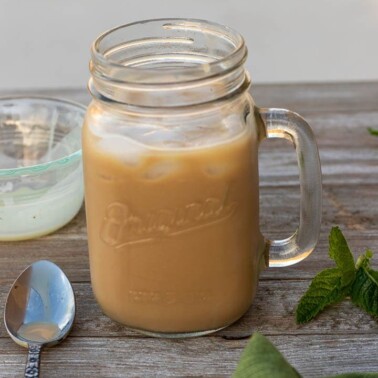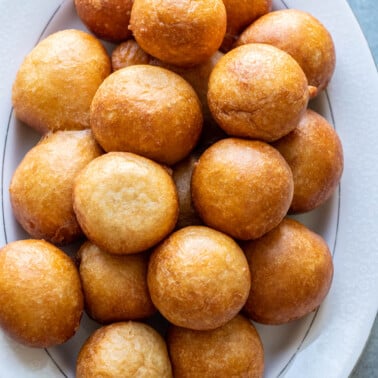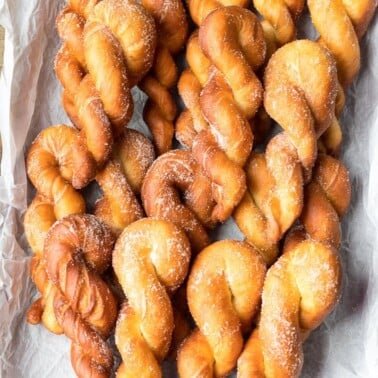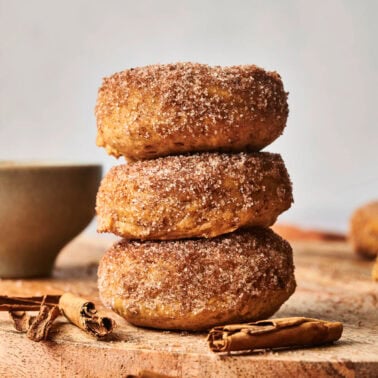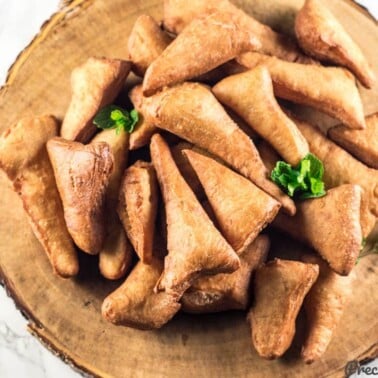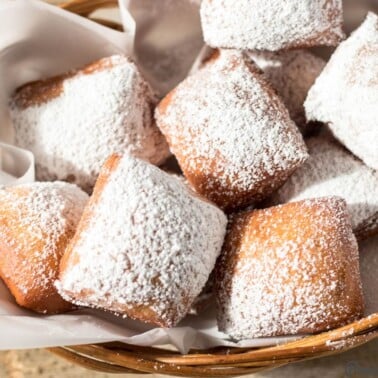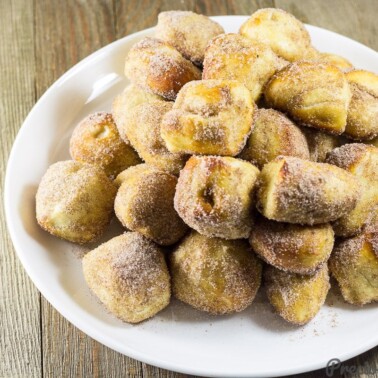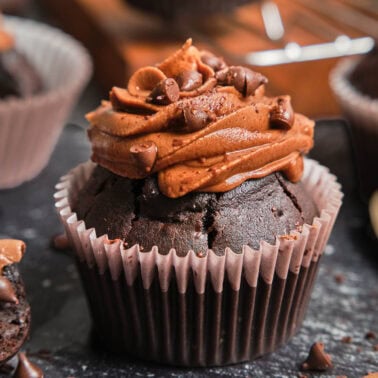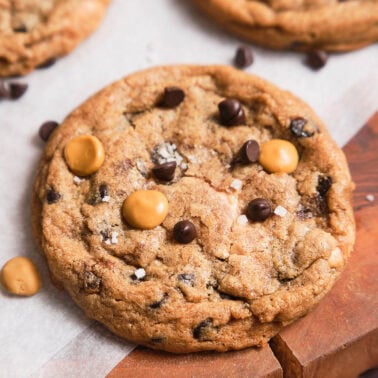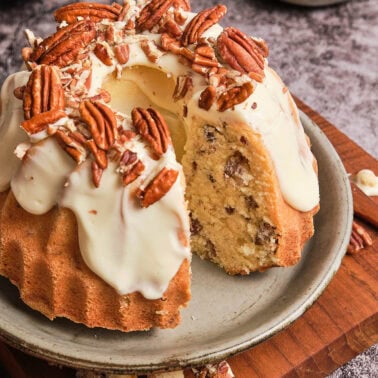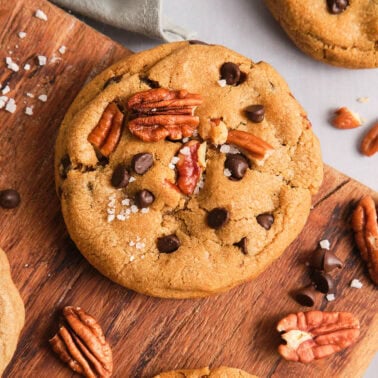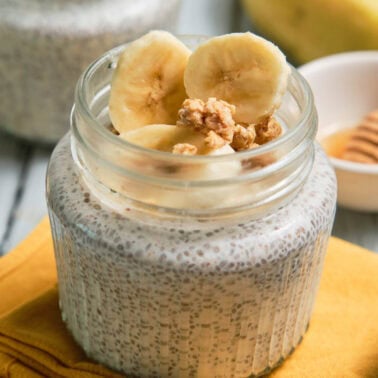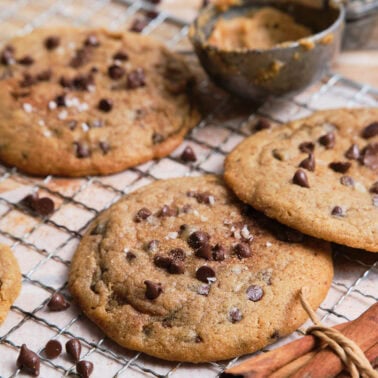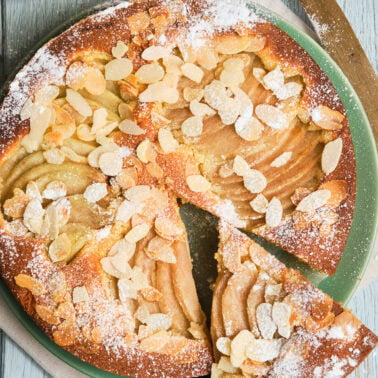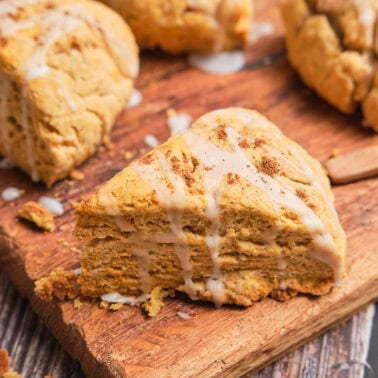Sugar Coated Donuts
Published Mar 08, 2024
Updated Oct 29, 2024
This post may contain affiliate links. Please read our disclosure policy.
There’s nothing like hot, fresh, homemade doughnuts! So here is how to make soft, fluffy, and light Sugar Coated Donuts. These yeasted doughnuts have an unbeatable flavor thanks to the yeast, and they are so easy to make. Serve them alongside some hot tea, hot chocolate, or coffee!
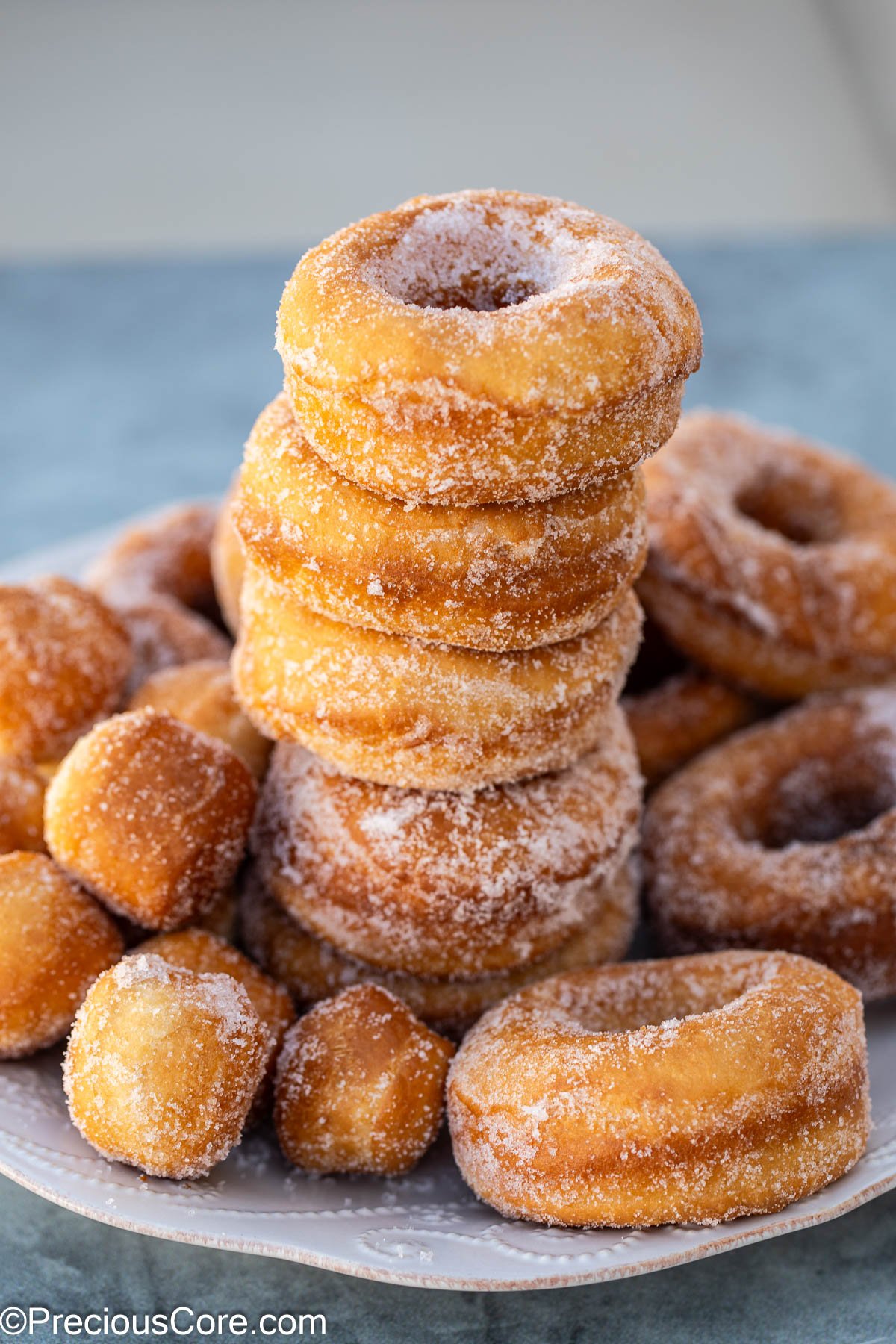
There’s no better way to treat your family than making these old-fashioned donuts on a weekend morning. My daughters are huge fans of these donuts. I know the delightful taste of these bakery-style donuts will surely bring joy to your kids’ faces too.
I know you can bake donuts, but personally, I prefer to fry them because they have a deeper flavor and color that you can’t achieve with baking. If you feel the same way, you can try some of my other fried donut recipes, too, such as African Doughnuts, Coconut Doughnuts, or Cameroon Doughnuts!
This sugar coated donuts recipe is perfect for making donuts that are just the right amount of sweet for a morning treat. However, don’t limit yourself to just enjoying them in the morning – they can be enjoyed any time of the day!
Table of Contents
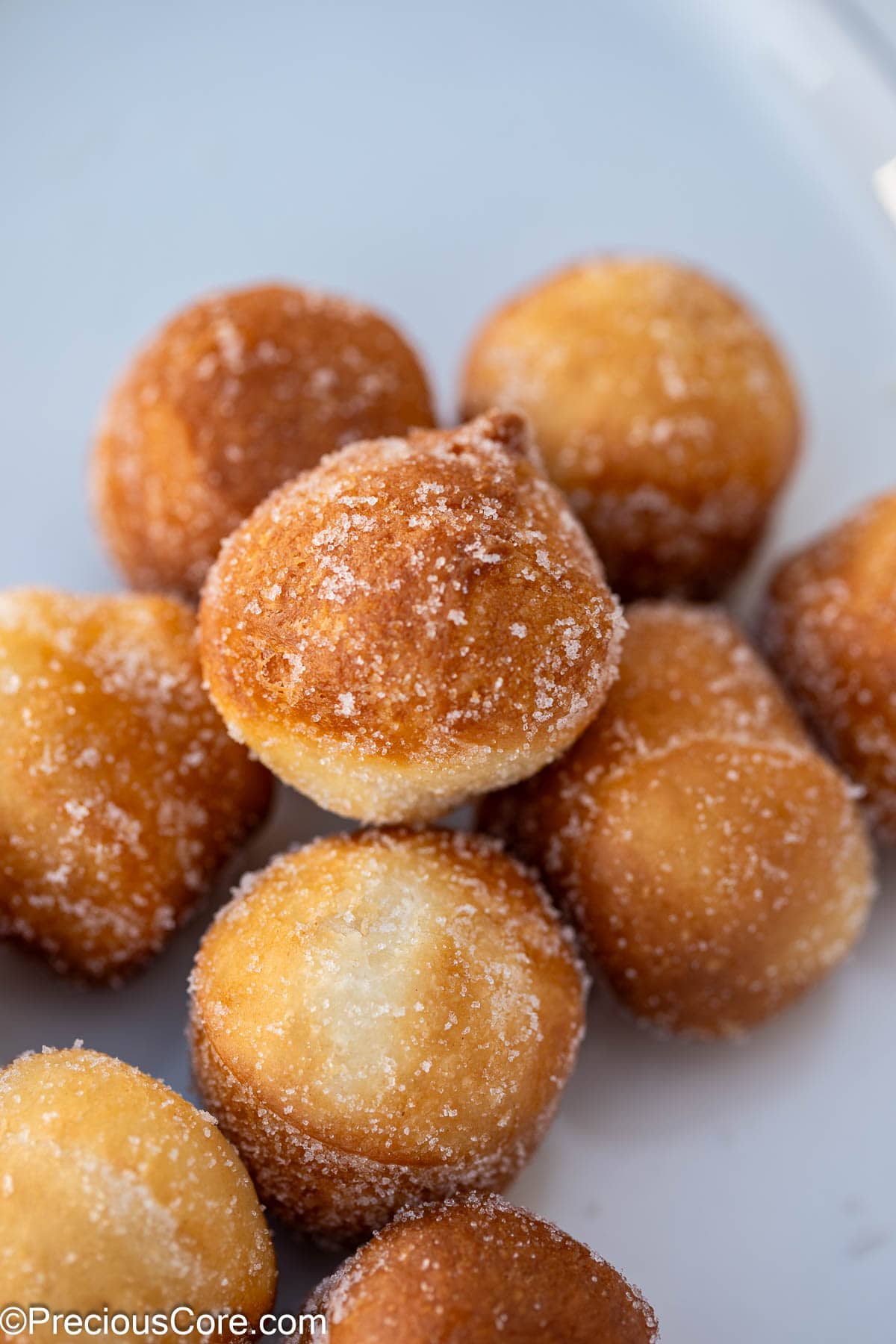
Why You’ll Love This Donut Recipe
- It’s classic. Nothing is more classic than a simple yet delicious doughnut coated in sugar! With its fluffy interior, it feels like you are biting into a cloud! When fried, the exterior becomes perfectly golden brown, while the sugar granules add a gentle sweetness and pleasant texture.
- It is adaptable. These donuts can be enjoyed for breakfast or dessert. Also, there are numerous ways to modify the recipe according to your taste. For example, you can make them festive for holidays or add spices to the dough or sugar coating. This basic recipe provides a solid foundation to let your creativity run wild!
- It’s fun. Making homemade baked goods can be a relaxing and exciting experience at the same time. It feels great to get in the kitchen and make classic pastries from scratch, and learning something new is always fun. You can even involve your kids and let them help you cut the donuts!
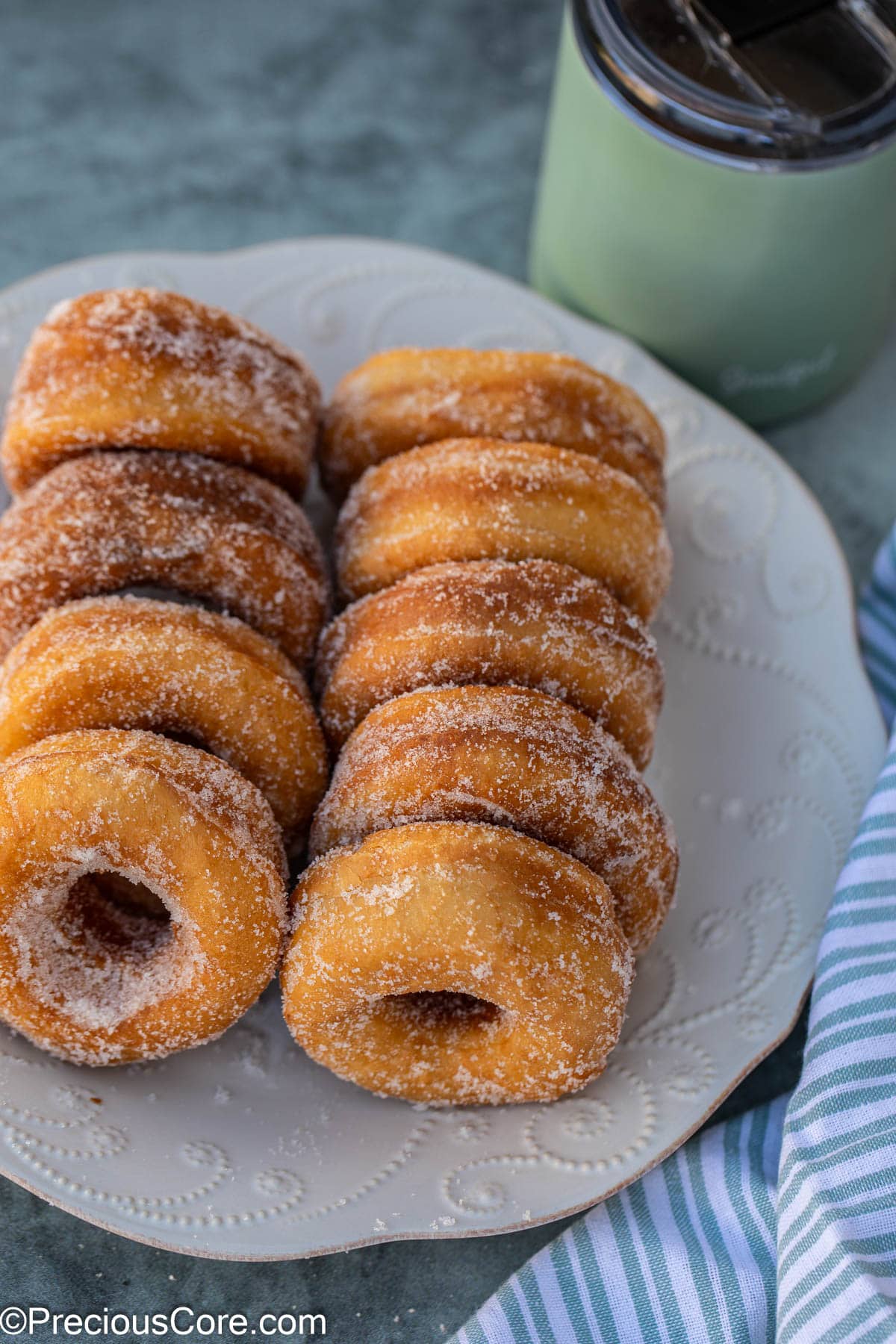
Ingredients For Sugar Coated Donuts
Here are some of the more important ingredients you need for this recipe and some notes about them:
- Active Dry Yeast: The yeast in this recipe is necessary because it helps the dough ferment, giving you a light and airy donut. Make sure to use active dry yeast, which you can find at your local grocery store!
- Granulated Sugar: You need a small amount of sugar for the dough itself, as well as for the sugar coating.
- All-Purpose Flour: For the best results, it’s recommended to use all-purpose flour. Other types of flour may affect the texture of the dough since the recipe’s ingredients were measured with all-purpose flour in mind.
- Butter: The butter creates a super soft dough, improving its texture and adding richness. Make sure to use unsalted butter so the dough doesn’t become overly salty!
- Oil: You will need olive oil for greasing the bowl and vegetable oil for frying. However, other oils can be used for frying, so more on that later!
For the full list of ingredients with measurements, check out the recipe card below.
How To Make Sugar Coated Donuts
Here is how to make sugar coated donuts broken down to 4 easy steps.
- Proof the yeast and combine all the ingredients to form a dough.
- Let the dough rise in a warm place.
- Roll out the dough and cut out the doughnuts. Let the donuts rest.
- Deep fry the donuts and coat with sugar.
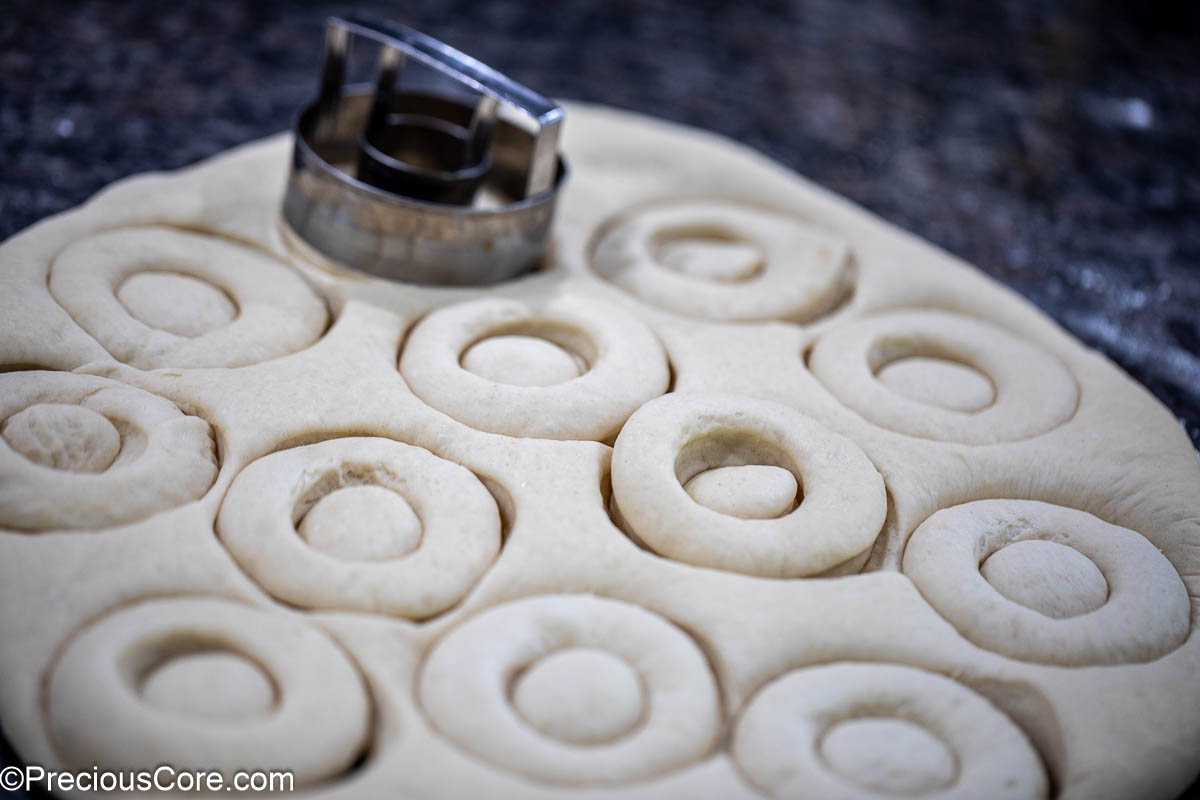
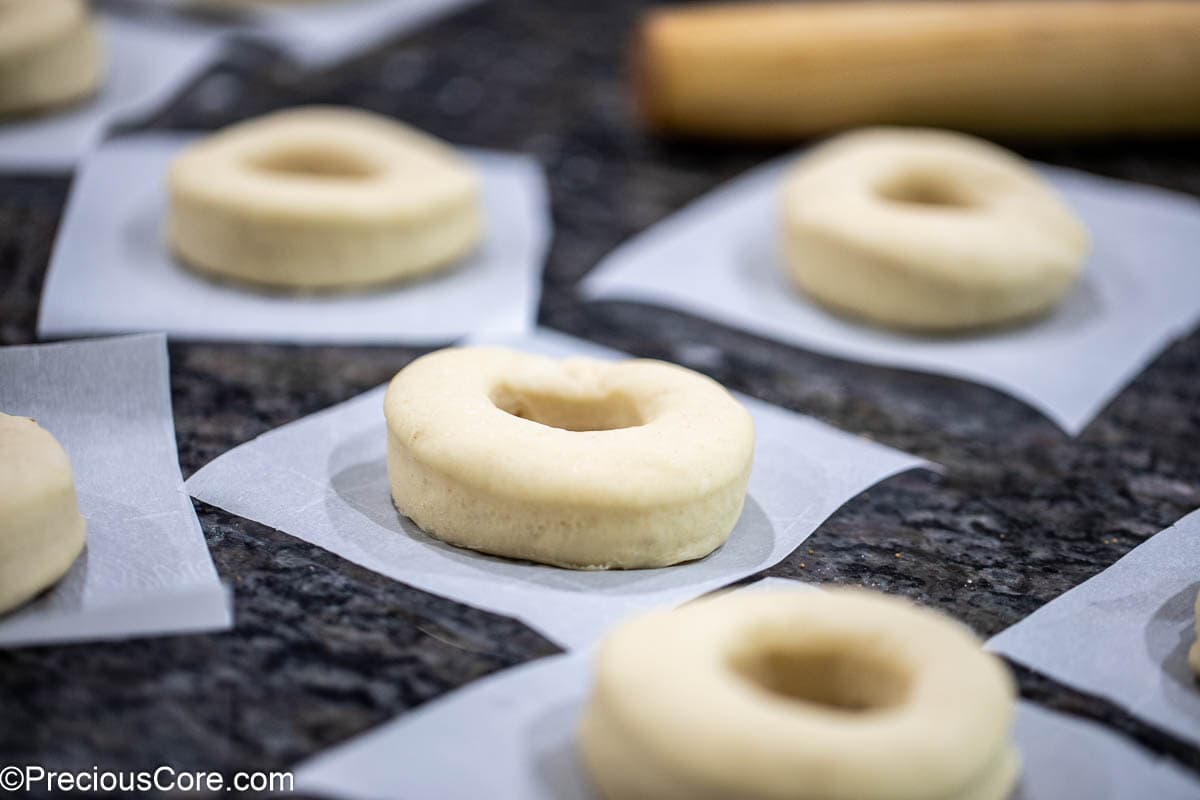
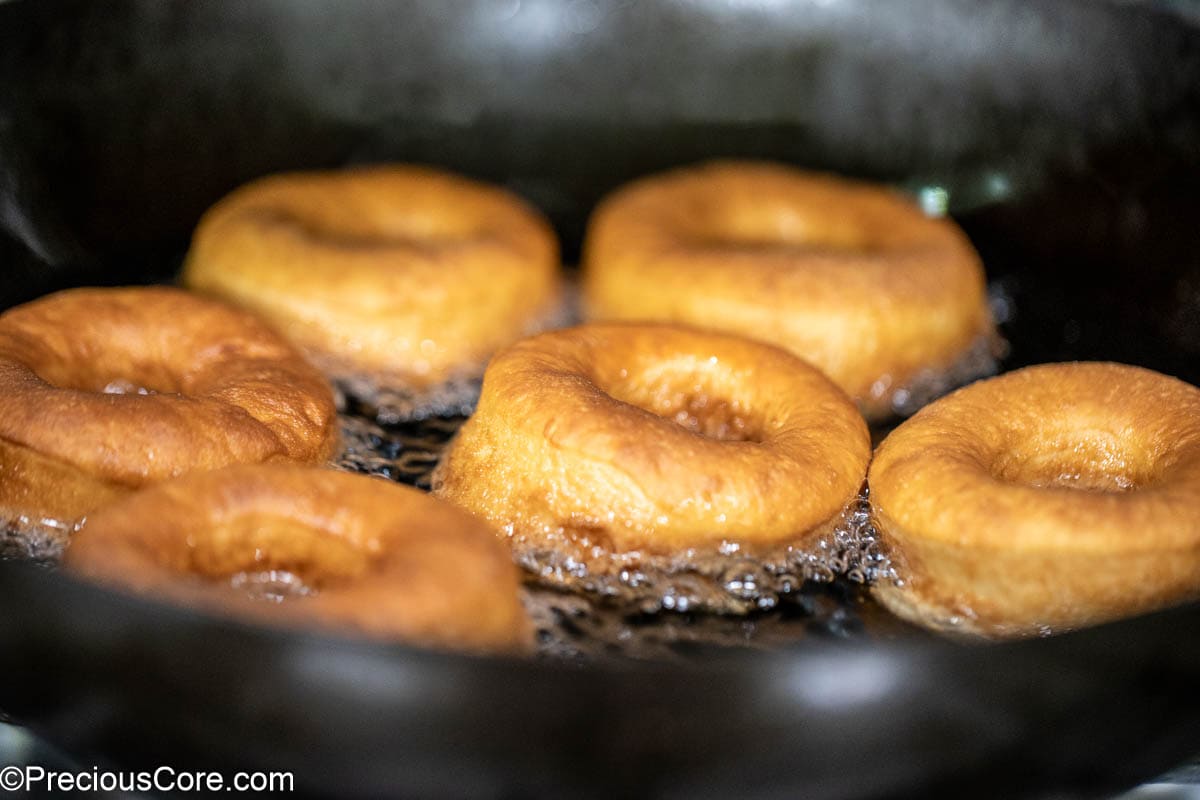
Substitutions and Variations
- Cinnamon: To make decadent cinnamon-sugar donuts, add two teaspoons of cinnamon to the granulated sugar before coating them!
- Lemon: Looking for a citrusy pastry? Make lemon sugar donuts by adding one tablespoon of fresh lemon zest to the granulated sugar before coating them.
- Powdered Sugar: If you prefer powdered sugar doughnuts, you can easily do so. However, the sugar will melt if you coat them when they’re too hot. It’s best to allow them to cool slightly before coating them. If some of the sugar coating dissolves, you can simply toss the doughnut in more sugar to give it an even coating.
- Oil: If you don’t have vegetable oil, you can use another oil for frying, such as corn oil, peanut oil, or canola oil.
- Milk: The whole milk in this recipe can easily be substituted with 2% milk with no issues!
- Flour: As mentioned earlier, AP flour is best. However, if you don’t have it, you can substitute it with bread flour at a one-to-one ratio. Keep in mind that it will slightly alter the texture of the doughnuts! However, they’ll still be delicious.
For a baked donut option, check out my Pumpkin Spice Doughnuts.
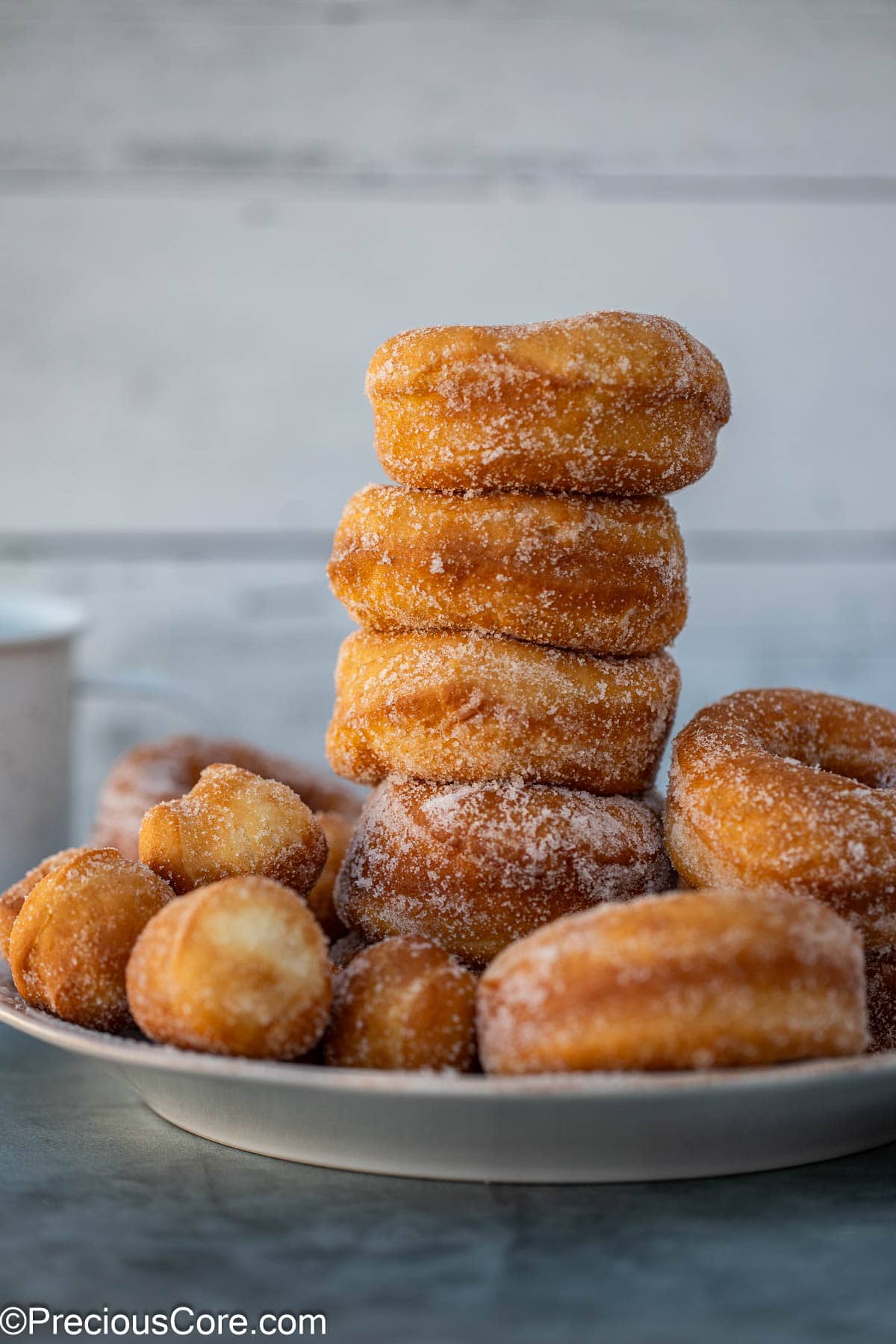
Expert Tips For Donuts
- Make sure to follow the guidelines for the oil’s temperature when frying. Unfortunately, if your frying oil is too cold, the doughnuts will soak up all the oil, turning out super greasy. On the other hand, oil that’s too hot will make the outside of the pastry too dark while the inside is raw.
- Don’t crowd the pot when you fry the donuts. You will need enough room to flip them over halfway through cooking. When they have some space in between them, they cook more evenly.
- When heating the milk and proofing the yeast, make sure that its temperature doesn’t exceed 115°F (46°C) because yeast cannot survive above that temperature. If the yeast dies, the doughnuts will turn out dense instead of fluffy!
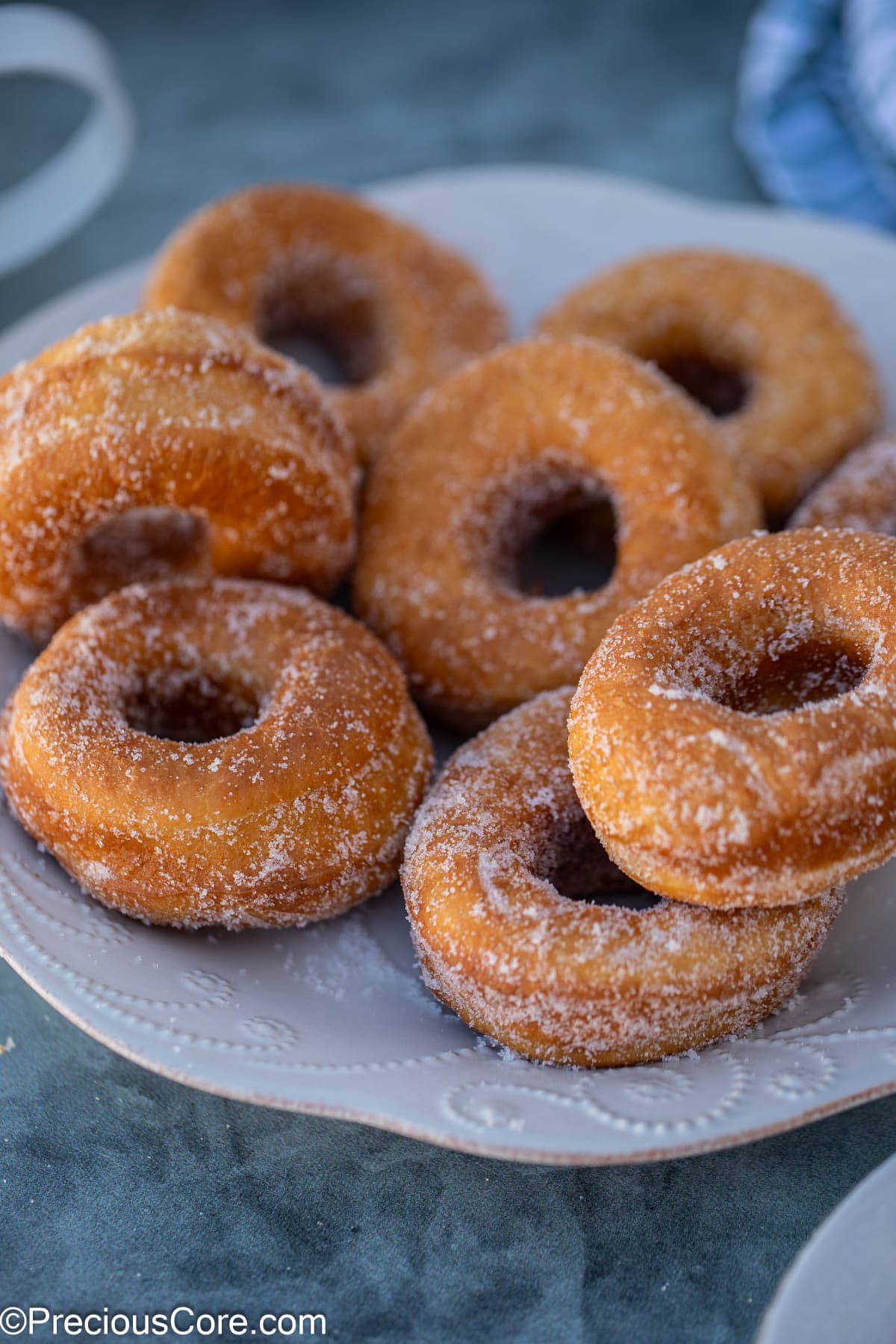
Recipe Frequently Asked Questions
It’s important to coat the doughnuts with sugar immediately after frying to ensure it sticks. If you wait too long, the sugar won’t adhere. That’s why I recommend working in batches because it is easier to manage.
However, you can still make it work if the donuts have already cooled down. Melt some butter in the microwave, gently brush it on the fried donuts, and then coat them with the sugar mixture. Be careful not to use too much butter because it will make them soggy.
If your donuts turned out dense, it could be because you either over-mixed the dough or didn’t allow it enough time to rest. When working with yeast, you should keep both of these factors in mind.
You should mix and knead the dough until it is no longer sticky, but avoid kneading it as you would with bread. Doughnuts should have a more tender crumb. Additionally, if you try to rush the process when the dough is rising, it will likely turn out dense. Wait for it to double in size!
To properly store them, place the fully cooled doughnuts in an airtight bag in the fridge. They will last approximately 7 days! If you don’t want to eat them cold, you can reheat them.
Either microwave them for 30 seconds or bake them at 300℉ (148℃) for about 10 minutes.
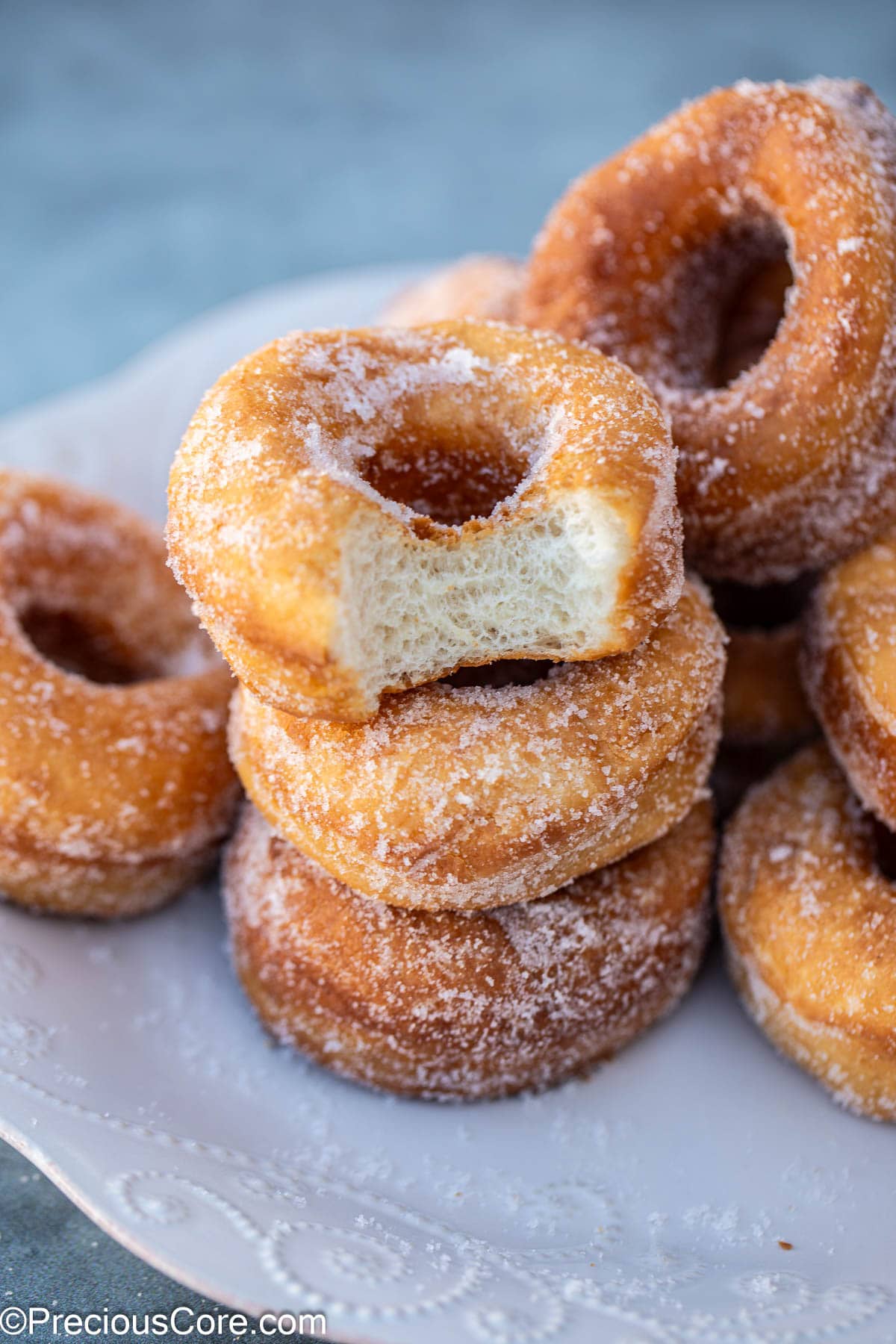
Serving
Serve sugar coated donuts with:
Similar Recipes
More Desserts
If you make this recipe please leave a star rating below. Your rating helps others find the recipe plus I love hearing from you! Thank you!

Sugar Coated Donuts
Ingredients
- 1½ cups whole milk sub with 2% milk
- 2¼ teaspoons active dry yeast
- 3 Tablespoons granulated sugar
- 1 teaspoon salt
- 3 Tablespoons melted butter unsalted
- 1 large egg
- 4¾ cups all-purpose flour
- 1 Tablespoon softened butter unsalted
- 1 Tablespoon olive oil for rubbing bowl
- 4-5 cups Vegetable oil, for frying Canola oil, vegetable oil, corn oil, or peanut oil all work
For Coating the Doughnuts
- ⅓ cup granulated sugar
Instructions
- Proof the yeast: Set a small pot on medium heat. Add the milk and warm it to about 115 ℉ (46℃). Add the milk to the bowl of a stand mixer or if mixing by hand, add the milk to a large mixing bowl. Add the yeast and 1 Tablespoon of the granulated sugar. Stir to combine and let it sit for about 5 minutes. The mixture will turn creamy and bubbles will form on top, showing that the yeast is active.
- Make the dough: Add the remaining 2 Tablespoons of granulated sugar, salt, melted butter, egg, and all-purpose flour. Mix to form a dough with the stand-mixer set on low to medium speed.
- Add the butter: Once all the ingredients for the dough come together, you'll find the dough slightly sticky. Add one Tablespoon of softened butter and knead on low speed for about 3-5 minutes until the butter is well incorporated and the dough doesn't stick to the bowl.
- Let it rise: Remove the dough from the bowl and brush the bowl with olive oil or spray with cooking spray. Add back the dough to the bowl and turn the dough around to ensure the oil completely coats the dough. Cover with a clean kitchen cloth and set in a warm place to rise for one hour or until doubled in size. To create a warm space, turn on the oven lights and place the dough in the oven to rise (the oven should be turned off).
- While the dough rises, cut out twenty 5 by 5-inch squares of parchment paper.
- Cut out doughnuts: Punch the risen dough to remove the excess air bubbles. Lightly flour a clean working surface, then place the dough on the working surface and roll it out to be half an inch thick. Cut out doughnuts and doughnut holes with a 3-inch doughnut round cutter. Place each doughnut on a 5 by 5-inch square of parchment paper and place the doughnut holes on a parchment paper-lined baking sheet. Gather the rest of the dough into a ball, then roll out and cut out more doughnuts. Repeat the re-rolling and cutting process with the rest of the dough.
- Fry: While the doughnuts rest, fill a heavy pot (cast iron) with neutral oil ( for example, vegetable or canola oil) up to 2 inches. Heat the oil to 350℉ (176℃). Gently lower the doughnuts into the oil, starting with the doughnuts that were cut out first. Fry not more than six doughnuts at a time for about 1-2 minutes per side until golden brown. Transfer the cooked doughnuts to a paper towel-lined baking sheet to absorb the excess oil.
- Coat with sugar: Using kitchen tongs, transfer the hot donuts to a grocery paper bag, then sprinkle on one tablespoon of the sugar for coating. Shake well to ensure the sugar coats the doughnuts. Repeat the frying and coating process with the rest of the doughnuts and finally fry the doughnut holes.
- Serve doughnuts warm for with tea, hot chocolate, or coffee. Store completely cooled doughnuts in an airtight bag in the fridge for up to a week. Reheat a doughnut in the microwave for 30 seconds or in the oven at 300℉(148℃) for 10 minutes.
